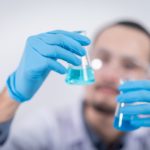How to Become a Pharmacist: Steps to Take from High School
From working behind the glass at your local pharmacy to preparing medication for patients in a hospital, being a pharmacist offers a variety of pathways. The career is also well-compensated, earning six figures on average. There are a lot of steps a high school student must take, however, before they don the ubiquitous white coat, including many years of schooling. However, with proper planning and an understanding of the requirements necessary to become a pharmacist, students can expedite the time required in college and get a jump start on their career. The majority of pharmacists work in commercial operations such as drug, grocery, and big-box stores. According to the Bureau of Labor Statistics (BLS), 42% of pharmacists work in pharmacies and drugstores. Pharmacists in these settings fulfill many duties, including the safe dispersal of medication (for example, ensuring it won’t interfere with a patient’s other meds or allergies), educating patients about medication, and overseeing a staff of pharmacy technicians and aides. The other primary employers of pharmacists are hospitals; the BLS reports that they employ 26% of the people working in the occupation. As the US population continues to age, the need for pharmacists in healthcare settings, such as hospitals, is anticipated to grow. Pharmacists working in hospitals also fulfill a multitude of roles—they prepare medication for patients, advise staff on medication options, and educate patients about medications and how to use them. Due to the importance of their position and the vast amount of training required to attain it, pharmacists are well compensated. In 2020, the BLS announced that the average pharmacist earned $128,710 annually. The region a pharmacist works in and the amount of experience they have will affect their earnings. There are two common paths that students follow toward a career as a pharmacist. One path is through a traditional undergraduate program. Students choosing this course spend at least two years studying as an undergraduate, but most will earn a 4-year bachelor’s degree to be a competitive applicant to graduate pharmacy programs and complete all pre-requisite courses. The other path is a combined—or dual degree—program, where you earn both your bachelor’s degree and PharmD over the course of the program. Dual degree pharmacy programs are also commonly referred to as “0-6” programs because they typically last six years; the first two years are spent on pre-professional study and are followed by four years in a professional pharmacy degree program. The benefit of these programs is two-fold: one, students don’t need to take the PCAT (Pharmacy College Admission Test), and students get their PharmD on an accelerated timeline. If a student gets an undergrad degree first, it’ll take them 8 years to get a PharmD (4 years undergrad, 4 years PharmD), versus the 6 years of a dual degree program. Keep in mind that many students complete 1-2 years of residency after their PharmD, making the total amount of time to become a full-fledged pharmacist 9-10 years on the traditional path, or 7-8 years on the accelerated one. Similar to “0-6” programs are early assurance programs, where students usually apply in high school and are guaranteed admission into a PharmD program on completion of the undergraduate requirements. These programs may or may not be on an accelerated timeline, but the main benefit is guaranteed acceptance into pharmacy school as a high schooler, so students also don’t have to worry about taking the PCAT and applying to PharmD programs. There are multiple pathways for students interested in a career as a pharmacist, but with proactive planning, students can reduce their time spent in school—along with the cost of extra, unnecessary classes—and earn their white coat sooner rather than later. Having a solid foundation of math and science will serve students well throughout their pursuit of a Doctor of Pharmacy degree (PharmD). Students should take classes in biology, chemistry, physics, and math, and take them at an advanced level. In addition to science skills, pharmacists need to pass their knowledge of medication on to medical staff and patients, making good written and verbal communication skills a valuable asset. To strengthen the skills needed to become a pharmacist, students might pursue extracurriculars in STEM, healthcare, or communication. Some ideas of extracurriculars might be: Students should also consider shadowing a pharmacist, or observing them at work. If that’s not possible, you can also conduct an informational interview, where you ask questions about the pharmacist’s day-to-day life and their professional path. This is especially important to understand the nuances of the role, and can even help you establish a long-term mentor in the field. Undergraduate + Graduate School Path Completing an undergraduate degree before going to graduate school is a longer road to becoming a pharmacist than a dual degree program, but it offers more flexibility for students who are unsure of their career aspirations. Popular undergrad programs for students on this path include biology and chemistry. Similar to pre-med, pre-pharmacy isn’t a program or major; rather, it’s a track or collection of required classes. You can technically be pre-pharmacy and major in anything. The limiting factor is the number of required science classes to apply to PharmD programs. Because there are so many science prerequisites, many students choose to major in science. Although prerequisites vary by school, commonly needed classes include: All prospective PharmD students must take prerequisite courses, regardless of whether they’re on the traditional undergraduate + graduate path or an accelerated timeline. Provided an undergraduate has completed the prerequisite coursework, they can apply to a four-year professional pharmacy program after two years of study. Again, many candidates choose to spend more time in college, and even get a bachelor’s degree before applying to PharmD programs. Traditional students will also likely have passed the Pharmacy College Admission Test (PCAT), a five-section exam covering writing, biological processes, chemical processes, critical reading, and quantitative reasoning. The PCAT required at the large majority of pharmacy schools. Many PharmD programs also look for experience working, volunteering, or shadowing in a pharmacy, or other similar settings such as hospitals and nursing homes. Requirements vary from school to school, and in many cases, work experience is not required but encouraged. For example, The University of Minnesota lists in their criteria for admission that “the average admitted applicant has about 2 years of paid pharmacy or healthcare experience (full or part-time).” Likewise, the University of Michigan will “also take into account such factors as life, work, and health-care patient experiences” when making admissions decisions. “0-6” Program Path “0-6” programs award both a bachelor’s degree and PharmD upon completion, and are the faster of the two paths toward a career as a pharmacist. These are competitive programs, however, and students hoping to get accepted into them frequently need to meet a minimum GPA along with SAT or ACT scores. If you’re absolutely sure you want to pursue a career as a pharmacist, “0-6” programs offer the shortest and most cost-effective route to it. Be aware, however, that if you fail to maintain a satisfactory GPA or complete required courses, you can lose your place in the program. There are many factors to consider when choosing an undergraduate college with the hopes of becoming a pharmacist, including cost, predicted salary, and your chances of acceptance. If you want to find schools based on major and other factors, we recommend using our Hub tool to find schools. When you create a free account, you’ll also be able to calculate chances and find projected salaries based on major and university. Pharmacy students can expect to take courses in drug design, drug evaluation, and the effect of drugs on the body. They will also learn how to best advise patients, dispense medication, and manage day-to-day business logistics, such as accounting and legal issues. In the final years, PharmD students will gain firsthand experience through experiential learning programs, most commonly divided into Introductory Pharmacy Practice Experiences (IPPEs) and Advanced Pharmacy Practice Experiences (APPEs). IPPEs are completed throughout a student’s first three professional years. APPEs take place in the fourth professional year, placing students in settings such as hospitals, physician’s offices, and pharmaceutical companies under the supervision of licensed pharmacists, allowing them to gain practical experience. After receiving their PharmD, most students will go through a residency in order to gain hands-on experience and further their education. These residencies are broken into two categories: Post Graduate Year 1 (PGY1) and Post Graduate Year 2 (PGY2). PGY1 builds on the skills, knowledge, and abilities gained in the PharmD program, while PGY2 allows participants to explore a particular field of interest, such as Drug Information, Managed Care, Pharmacy Systems, Medication-Use Safety, or Pharmacotherapy. To practice as a pharmacist in the US, you must pass two examinations: the North American Pharmacist Licensure Exam (NAPLEX) and the Multistate Pharmacy Jurisprudence Exam (MPJE). The NAPLEX is designed to test your decision making and ability to make safe choices for your patients, while the MPJE is a test of federal and state pharmacy laws. Additionally, some states have further requirements to practice as a pharmacist. Even after completing such a demanding journey to a career as a pharmacist, you should plan on a lifetime of learning. As of 2016, all states require pharmacists to complete continuing education hours to maintain their license. In general, anticipate dedicating between 15 to 30 hours to continuing ed between each license renewal period. You can be a pharmacist in many different settings, some of which may be unexpected. Here are some popular options: This is likely what most people think of when they hear the word “pharmacist.” Many pharmacists work in commercial pharmacies at supermarkets or in independent pharmacies to dispense medication. They may also administer vaccines and educate patients about their medication. Pharmacists in hospitals work alongside doctors, nurses, and other health professionals to determine the best medication types and doses for the patient’s treatment plan. Pharmacists may work in the industry to help develop, test, regulate, or market new drugs. Jobs in the industry tend to be better-compensated than those in a clinical setting. Different levels of government require the expertise of pharmacists, particularly when it comes to public health departments. At the federal level, the National Institutes of Health and the Food and Drug Administration may offer employment opportunities. If you’d like to educate the future generation of pharmacists, pharmacy schools need faculty to teach courses and clinical skills, plus conduct research. Want access to expert college guidance — for free? When you create your free CollegeVine account, you will find out your real admissions chances, build a best-fit school list, learn how to improve your profile, and get your questions answered by experts and peers—all for free. Sign up for your CollegeVine account today to get a boost on your college journey.
What’s Covered:
What Does a Pharmacist Do?
How Much Do Pharmacists Make?
How Long Does it Take to Become a Pharmacist?

How to Become a Pharmacist: Steps to Take From High School
High School
College
Find the right type of undergrad college to attend
Pharmacy School
Residency
Licensing
Career Paths
Commercial or independent pharmacies
Hospital pharmacies
Pharmaceutical industry
Government agencies
Academia



